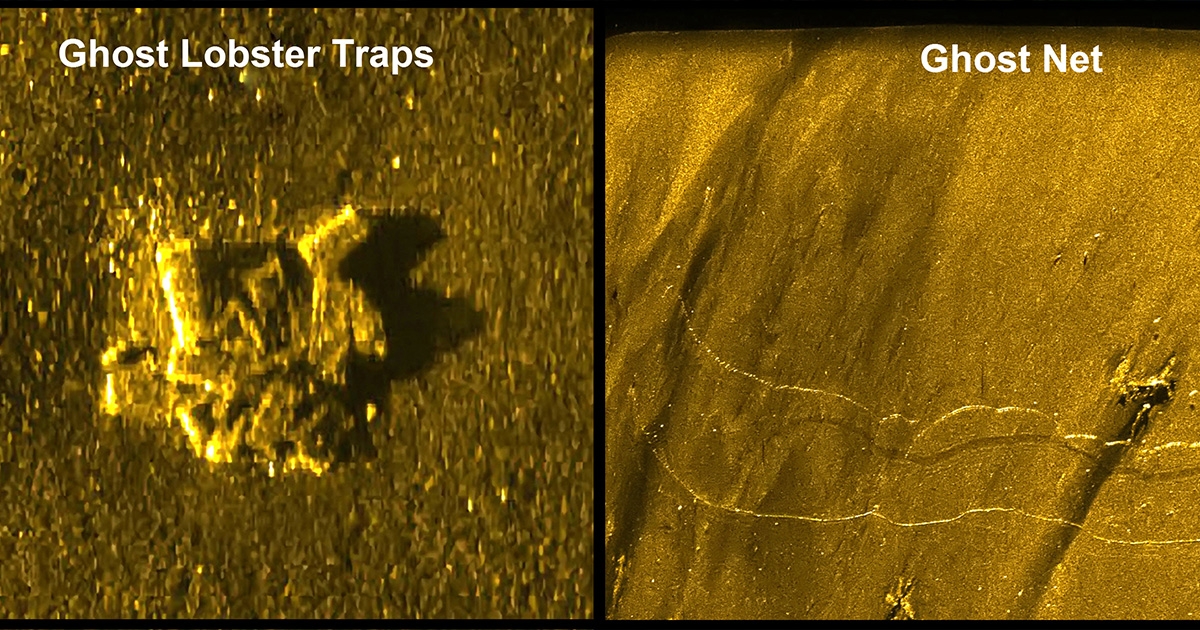The Future of Ghost Gear Looks Less Haunting with Side Scan Sonar Intervention

Ghost gear is lost or discarded fishing equipment—nets, ropes, and abandoned traps or pots—that continues to fish long after being lost or discarded, sometimes for years. The unfortunate result is the quiet killing of fish, turtles, lobster, crabs, and entangling mammals such as seals, whales, and dolphins.
The United Nations Environment Program Report of 2009 estimates that over 640,000 tons of fishing gear is lost or discarded every year into the oceans. It is suggested that this results in the death of 150,000 whales around the globe every year.
Ocean nations have become very aware of the issue and various agencies and non-profit groups are acting to now fund projects to locate and recover these deadly marine-animal-booby-traps. It turns out that side scan sonar, designed to map the seafloor, is a very effective tool to help locate and map ghost gear.
SONAR SURVEILLANCE
Ultra-high resolution side scan sonar systems, like the EdgeTech 4125i 600/1600 kHz, are presently in use by various organizations around the world to locate piles of ghost traps, including lost nets. Once located, recovery operations using grapples, divers, or ROVs are used for the removal and disposal. Being lightweight and portable, the intuitive side scan sonar systems can be operated out of any vessel of opportunity and require very little training for organizations to become operational.
The sonar systems, besides being used for ghost gear location, are also in use by marine fisheries law enforcement. Agencies such as NOAA’s Marine Fisheries Law Enforcement branch use side scan sonar to monitor illegal fishing activities as well as observing in-situ commercial fishing deployments of traps and nets on the seafloor. The sonar imagery allows the verification of the location and number of traps in a string as well as showing any floating net ropes etc. that may entangle whales, or other marine life. It has become a valuable tool in the day-to-day enforcement of fishing regulations.
IDENTIFYING THE THREAT
The oceans have become the world’s dumping ground for lost or discarded old fishing gear, and the impact on the ocean environment is undeniable. A greater investment in expanding programs for ghost gear recovery needs to be done as well as educating the commercial fishing community that using the ocean as a dumping ground for old fishing gear is doing major damage to the marine ecosystems that they rely on for their living. The old saying “out of sight, out of mind” mentality has no place when it comes to the world’s oceans.
Whales are not only impacted by ghost gear (floating derelict nets etc.), but existing commercial trap fishing, and the nets used, creates a second hazard from the age-old practice of having surface floats and down lines to the trap strings or bottom nets. The vertical lines are a major hazard to whale movement and migrations. EdgeTech has designed a new Ropeless Fishing System that removes vertical lines from the water column.
ROPELESS FISHING SYSTEM
The best way to reduce ghost gear is to prevent fishing gear from becoming lost in the first place.
EdgeTech has developed the 5112 Ropeless (End line on Demand) Fishing System (RFS) to eliminate the need for persistent vertical lines in the water column that connect fishing gear to a surface buoy. The intent is to alleviate possible whale and other marine-life entanglement, help prevent Ghost gear, relocate lost gear, and reduce gear conflicts.
The RFS consists of a release cage with the appropriate length of line stored in the cage, detachable floatation cover with an integrated EdgeTech 5112 rugged acoustic release transponder, deck unit with transducer and the EdgeTech Trap Tracker application running on an IOS or Android device.
The RFS release cage is set out like any other rope-and-buoy trap, it can be attached to a single trap or at the beginning and or end of a trawl line and then recovered like a standard trap and buoy. Commands from the Trap Tracker application are sent to the BLEAT deck unit that then sends the commands to the 5112-release mounted in the release cage. The RFS receives the command then acts and replies with information to the Trap Tracker application such as, RFS ID, deployed position, recovered position date and time which is then uploaded to the Trap Tracker database and is shared with other Trap Tracker users within a certain distance to protect the fishers’ privacy.
This visibility helps fishers to know where the EdgeTech RFS equipped gear is set even in fog or at night or from distances up to 5 nm away to help mobile fishers maneuver around long trap trawls preventing unintentional gear conflicts which is one of the main causes of ghost gear.
If gear has moved from where it was set for whatever reason, the RFS system can geo-locate underwater units using Ranging and Trilateration.
This geolocation feature allows Fishers to pinpoint the location of lost underwater units up to 2,000 meters (1 nautical mile~) away that may have moved from mobile fishing conflicts or some other means. By searching using a grid pattern, large areas can be covered quickly allowing for the relocation and recovery of lost gear.
There was a real-world incident that occurred in 2020 where a mobile fisher in a restricted area dragged off several 40 pot trawls. By using the ranging geolocation function, the Trap Fisher was able to locate and recover the trawls that were equipped with the EdgeTech RFS almost five miles from where they were originally set. Not only did this prevent 80 traps from becoming ghost gear but it saved the fisher over $15,000 to replace the lost gear.
For more information, visit: www.edgetech.com.
This feature originally appeared in Ocean News & Technology's Magazine December 2022 edition. To read more, access the magazine here.

